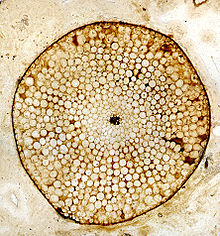Rhynia gwynne-vaughanii
| Rhynia gwynne-vaughanii | ||||||||||||
|---|---|---|---|---|---|---|---|---|---|---|---|---|

Rhynia gwynne-vaughanii , reconstruction |
||||||||||||
| Temporal occurrence | ||||||||||||
| Devonian ( Emsium / Eifelium ) | ||||||||||||
| approx. 396 million years | ||||||||||||
| Locations | ||||||||||||
| Systematics | ||||||||||||
|
||||||||||||
| Scientific name of the genus | ||||||||||||
| Rhynia | ||||||||||||
| Kidst. & Long | ||||||||||||
| Scientific name of the species | ||||||||||||
| Rhynia gwynne-vaughanii | ||||||||||||
| Kidst. & Long |
Rhynia gwynne-vaughanii is the name of an approx. 400 million year old fossil plant that waswidespread worldwidein the Lower Devonian . It was named after the Scottish village of Rhynie ( Aberdeenshire ), where it was first discovered in the 1910s in a silicified bog ( Rhynie Chert ). In 1917 they were scientifically described as Rhynia gwynne-vaughanii . A plant fossil also found in Rhynie was initially designated as Rhynia major , but due to some differences, it was later no longer included in the genus Rhynia and renamed Aglaophyton major .
The main axis of the plant ran horizontally as a rhizome in the ground. The walls of the cells responsible for the water supply ( tracheids ) showed helical and ring-shaped reinforcements. In Aglaophyton these reinforcements are missing. Above ground, the rungs were regularly dichotomously branched (that is, evenly forked) with a terminal sporangium . The shoots are therefore often interpreted as sporophytes and could rise up to 50 cm high. Nothing more is known about the generation change of the plant. The diameter of the shoot was a little more than 5 mm, there were no leaves.
Along with Horneophyton, Rhynia is considered to be the oldest land plant known to date . Since the formulation of the telome theory by Walter Zimmermann, it has therefore been cited in every paleontological manual as a model for the so-called primeval plants from which all later cormophytes developed.
literature
- Klaus, Wilhelm: Introduction to paleobotany. Volume II. Geological development of plants Vienna: Franz Deuticke Verlagsgesellschaft, 1986, ISBN 3-7005-4570-3
